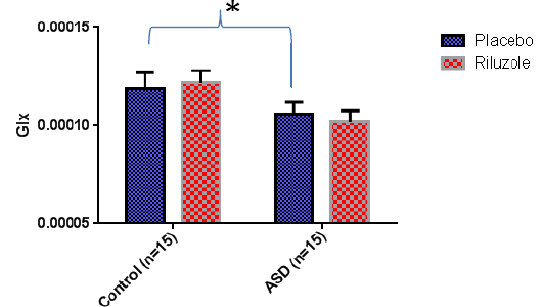Print version
Search Pub Med
Pharmacological modulation of brain excitatory/inhibitory balance in autism spectrum disorder
Background: There are no pharmacological treatments for the core symptoms of Autism Spectrum Disorder (ASD). However, accumulating evidence suggests an imbalance between excitatory (E) glutamate and inhibitory (I) GABA in ASD; and may explain the early promise of proGABA and anti-glutamate drugs such as riluzole. Here we tested the hypothesis that, compared to unaffected controls, individuals with ASD have differences in the E/I response to a riluzole drug challenge. Methods: 50mg of riluzole or matched placebo was administered orally in a randomised, double blind, crossover design, 1 hour before scanning. MEGAPRESS proton magnetic resonance spectroscopy ([1H]-MRS) was used to measure concentrations of Glx (glutamate + glutamine) and GABA in the frontal lobe and subcortex of men with and without ASD. An inhibitory index was calculated as GABA/(GABA+Glx). Whole brain resting-state fMRI (rs-fMRI) data was acquired as an indirect measure of E/I influence on widespread brain networks. A significance threshold of p < 0.05 was adopted for all analyses. Results: Subcortical GluX was significantly lower in men with ASD compared to controls at baseline (placebo, p=0.03) [Fig A]; Riluzole significantly increased the inhibitory index in the subcortex of both groups (p = 0.02). However, in the prefrontal cortex, riluzole increased the inhibitory index in the ASD group only (p=0.04). Post-hoc testing suggested that increases in inhibitory indices in both groups were driven by increased GABA. Differences in frontal lobe connectivity in ASD appeared normalized by riluzole.
Figure A. Lower resting (placebo) Glx concentration in the Sub cortex of ASD patients. p=0.03.
Conclusion: Individuals with ASD have differences in E/I balance (lower subcortical Glx in ASD) and responsivity (Riluzole increases inhibition in the cortex of ASD patients only), at regional (shown by MRS) and whole-brain levels (shown by fMRI). Thus, the glutamate-GABA system may be a tractable treatment target in ASD. This MRS/rs-fMRI approach may provide a safe means to fractionate the ASD sample into more biologically homogeneous sub-groups, for example prior to clinical trial. It may also help predict who will be responsive to glutamate-GABA treatments (such as riluzole).
|



